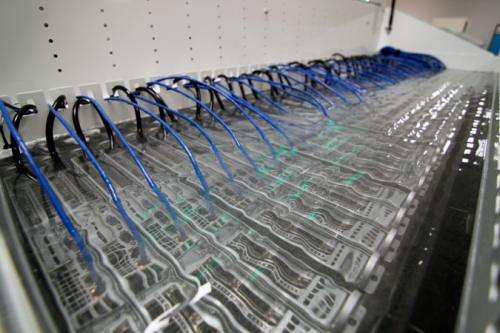September 3, 2012 report
Intel does math on oil-dunk test for cooler servers

(Phys.org)—Intel just finished a yearlong test of Green Revolution Cooling's mineral-oil server-immersion technology. Intel has tried immersing servers in the company's oil formulation to keep the servers cool and they report good results. The Intel servers were subjected to a yearlong bath in boxes filled with the oil-based coolant. Intel's results are one more way for the Austin, Texas-based company to pass along a convincing message that dipping a data center's servers in oil is not crazy but a sane way to cool the data center's power-hungry machines. The company believes its liquid cooling enclosures can cool high-density server installations at less cost. "We can reduce cooling energy use by 90 to 95 percent while also reducing server power by 10 to 20 percent," according to the company.
Intel reports that the servers ran at a PUE just above 1.0, and showed no damage. Translation: Traditional air-cooled server racks often operate at a Power Usage Effectiveness rating of about 1.6. Intel's oil-immersed servers operated at a PUE between 1.02 and 1.03, according to Mike Patterson, senior power and thermal architect at Intel.
Patterson said the oil-dunking approach is now in Intel's evaluation phase. Intel will need to understand the fuller implications of oil-optimized platforms.
Potentially, the approach may reduce the cost of running data centers, as cooling through the oil immersion system can bring reductions in average and peak power consumption. Those taking their first leap to use this oil immersion approach would be those who want as much power as possible coming out of their computing operations with as little as possible applied toward cooling.
Patterson said that the company found the technology to be safe for its server components. At the end of the test period, the Intel servers were placed in its failure-analysis lab, which did not find any damaging effects.
Green Revolution Cooling's product is called the CarnotJet System, defined as a fluid submersion cooling solution for data center servers. It uses nonconductive liquid coolant rather than air to achieve maximum cooling efficiency and performance.
Mention "oil" and add "servers immersed in oil" and for those not familiar with the results, this can sound very strange if not risky, Intel's Patterson said. That initial reaction is worth getting past. Patterson said Intel's research into how to build oil-optimized servers could result in a reference architecture around which server manufacturers could begin building such systems.
Already, Green Revolution Cooling has a list of customer centers running computer systems that make use of the approach. These include the Oil/Gas Seismic Processing Center; European Colocation Center; East Coast Corporate Data Center; US Research Institute; and the Texas Advanced Computing Center.
The coolant is clear, has a light viscosity, is odorless and is nontoxic. The company calls its coolant GreenDEF, which is a formulation of nonconductive white mineral oil. Their formulation is optimized for cooling servers and other data center hardware.
When compared to present-day design principles for keeping servers cool, the oil-immersion approach could have far-reaching effects. That is what Patterson means by its having an impact on a reference architecture around which server manufacturers can build their systems.
Oil immersion would do away with the need for raised floors and other requirements for air cooling. According to Green Revolution Cooling, energy is saved by removing server and power supply fans from the servers, as they are no longer necessary when servers are submerged.
The company also touts the advantage of server reliability, as the servers do not collect dust. Dust is a thermal insulator that raises server temperatures and reduces reliability. One recent study, they said, showed that dust accumulation increased power draw by 2 percent due to server temperature increases. The circulation of the coolant is said to be "excellent" with uniform temperatures without hot spots.
More information:
gigaom.com/cloud/intel-immerse … il-and-they-like-it/
www.grcooling.com/
© 2012 Phys.org

















